
A cloud forest, also called a water forest, primas forest, or tropical montane cloud forest, is a generally tropical or subtropical, evergreen, montane, moist forest characterized by a persistent, frequent or seasonal low-level cloud cover, usually at the canopy level, formally described in the International Cloud Atlas (2017) as silvagenitus. Cloud forests often exhibit an abundance of mosses covering the ground and vegetation, in which case they are also referred to as mossy forests. Mossy forests usually develop on the saddles of mountains, where moisture introduced by settling clouds is more effectively retained.
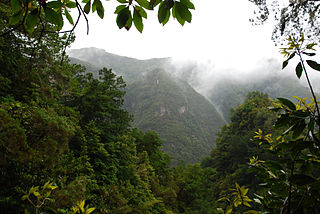
Laurel forest, also called laurisilva or laurissilva, is a type of subtropical forest found in areas with high humidity and relatively stable, mild temperatures. The forest is characterized by broadleaf tree species with evergreen, glossy and elongated leaves, known as "laurophyll" or "lauroid". Plants from the laurel family (Lauraceae) may or may not be present, depending on the location.

Pandanus is a genus of monocots with some 750 accepted species. They are palm-like, dioecious trees and shrubs native to the Old World tropics and subtropics. The greatest number of species are found in Madagascar and Malaysia. Common names include pandan, screw palm, and screw pine. They are classified in the order Pandanales, family Pandanaceae.
Litoria singadanae is a species of small green tree frogs reaching 35mm in length. It has long back legs, extensive webbing on the fingers and a prominent tympanum.
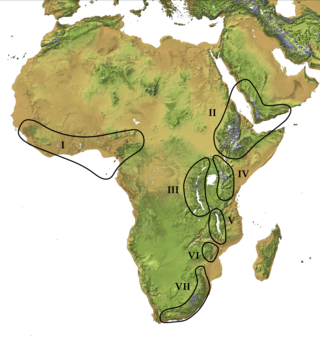
The Afromontane regions are subregions of the Afrotropical realm, one of the Earth's eight biogeographic realms, covering the plant and animal species found in the mountains of Africa and the southern Arabian Peninsula. The Afromontane regions of Africa are discontinuous, separated from each other by lower-lying areas, and are sometimes referred to as the Afromontane archipelago, as their distribution is analogous to a series of sky islands.
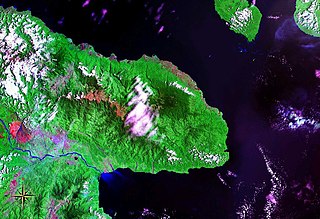
Huon Peninsula is a large rugged peninsula on the island of New Guinea in Morobe Province, eastern Papua New Guinea. It is named after French explorer Jean-Michel Huon de Kermadec. The peninsula is dominated by the steep Saruwaged and Finisterre and Cromwell Mountains. The nearest large town is the Morobe provincial capital Lae to the south, while settlements on the north coast include the former German town of Finschhafen, the district capital of Wasu, Malalamai and Saidor with its World War II era Saidor Airport.

Meesia triquetra, the three-ranked hump-moss, is a moss that occurs all around the northern hemisphere in higher latitudes.
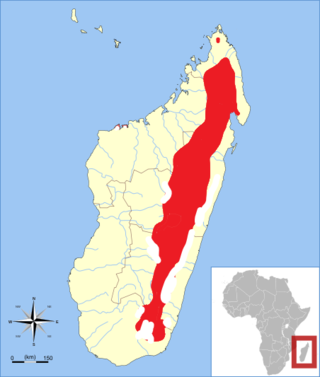
The grey-crowned tetraka formerly known as the grey-crowned greenbul is a species of Malagasy warbler in the family Bernieridae. It is found only in eastern and northern Madagascar.

The Papuan king parrot, also known as the green-winged king parrot, is a species of parrot in the family Psittaculidae found in New Guinea. Its natural habitats are subtropical or tropical moist lowland forest and subtropical or tropical moist montane forest.

The painted ringtail possum or moss-forest ringtail possum is a species of marsupial in the family Pseudocheiridae. It inhabits montane forests between altitudes of 450 to 3800 metres throughout the Huon Peninsula montane rain forests, Central Range montane rain forests and Huon Peninsula montane rain forests of Papua New Guinea. It has a diet of primarily leaves, including those of Medinilla.
Merrilliobryum is a genus of moss in family Fabroniaceae. The genus is found in New Guinea and the Philippines.

The Central Range sub-alpine grasslands is a montane grasslands and shrublands ecoregion on the island of New Guinea. The ecoregion covers the highest-elevation portions of the New Guinea Highlands, which extend along the spine of the island. The high elevations support rare tropical sub-alpine and alpine habitats, including many endemic plants and animals.
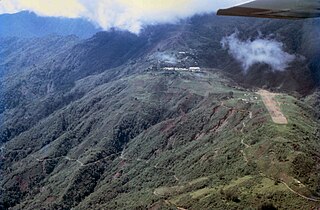
The Huon Peninsula montane rain forests is a tropical moist forest ecoregion in New Guinea. The ecoregion covers the mountains of northeastern New Guinea's Huon Peninsula.
Hylophorbus rainerguentheri is a frog species in the family Microhylidae. It is endemic to New Guinea and only known from the Huon Peninsula in the Morobe Province, Papua New Guinea. The specific name rainerguentheri honours Rainer Günther, a German herpetologist from the Natural History Museum, Berlin. Common name Huon Mawatta frog has been proposed for this species.

Montane ecosystems are found on the slopes of mountains. The alpine climate in these regions strongly affects the ecosystem because temperatures fall as elevation increases, causing the ecosystem to stratify. This stratification is a crucial factor in shaping plant community, biodiversity, metabolic processes and ecosystem dynamics for montane ecosystems. Dense montane forests are common at moderate elevations, due to moderate temperatures and high rainfall. At higher elevations, the climate is harsher, with lower temperatures and higher winds, preventing the growth of trees and causing the plant community to transition to montane grasslands and shrublands or alpine tundra. Due to the unique climate conditions of montane ecosystems, they contain increased numbers of endemic species. Montane ecosystems also exhibit variation in ecosystem services, which include carbon storage and water supply.
The Cromwell Mountains is a mountain range on the Huon Peninsula in north-eastern Papua New Guinea.

The karuka is a species of tree in the Screwpine Family (Pandanaceae) and an important regional food crop in New Guinea. The nuts are more nutritious than coconuts, and are so popular that villagers in the highlands will move their entire households closer to trees for the harvest season.

Fabroniaceae is a family of mosses belonging to the order Hypnales. It has a worldwide distribution, in temperate and tropical regions.

Pandanus solms-laubachii, commonly known as the swamp pandan, is a small tree in the family Pandanaceae which occurs in northeastern Queensland and possibly in Papua New Guinea. It is closely related to both Pandanus gemmifer and Pandanus grayorum.
Peltigera koponenii is a species of foliose lichen in the family Peltigeraceae. Found in Papua New Guinea, it was formally described as a new species in 2009 by Emmanuël Sérusiaux, Bernard Goffinet, Jolanta Miądlikowska, and Orvo Vitikainen. The type specimen was collected near Lake Wanba at an altitude of 2,400–2,500 m (7,900–8,200 ft), where it was found growing on a tree trunk in an open montane forest of Nothofagus and Pandanus. The species epithet honours Finnish bryologist Timo Koponen, "who made large and well processed collections of Peltigera in Papua New Guinea".














